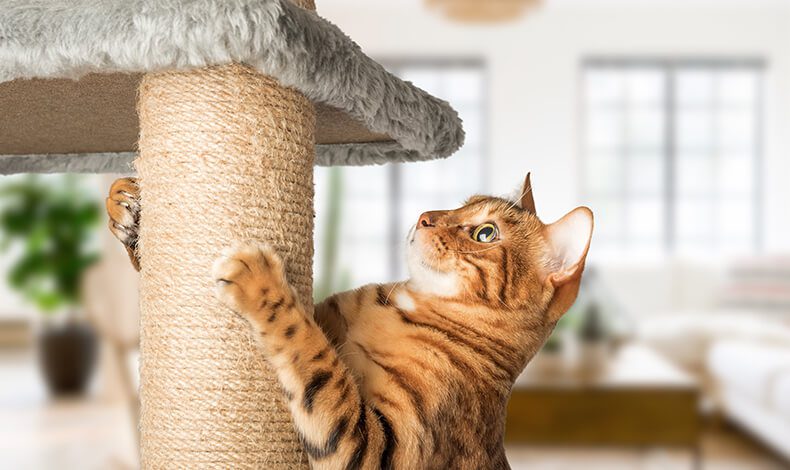As of December 1st, 2023, we will no longer be offering declaw services at our clinics. We wanted to take some time to explain scratching, the declaw procedure (and why it is no longer being offered), and some tips to live a happy co-existence with a clawed cat.
There are several reasons why cats scratch but here is a summary of the most common reasons:
- Territory marking. Cats want to let others know what they consider their “space” and will do so by using scent glands on their paws. This can be more pronounced in multi-cat households but can be used even in single-cat households. This can be exacerbated with stress and anxiety in the household. Providing adequate resources and reducing stress in the household (see below) can go a long way towards preventing this type of scratching.
- Stretching. Like us, cats like and need to stretch to loosen up their muscles.
- Claw maintenance. Scratching helps cats keep their nails healthy by removing the worn layers.
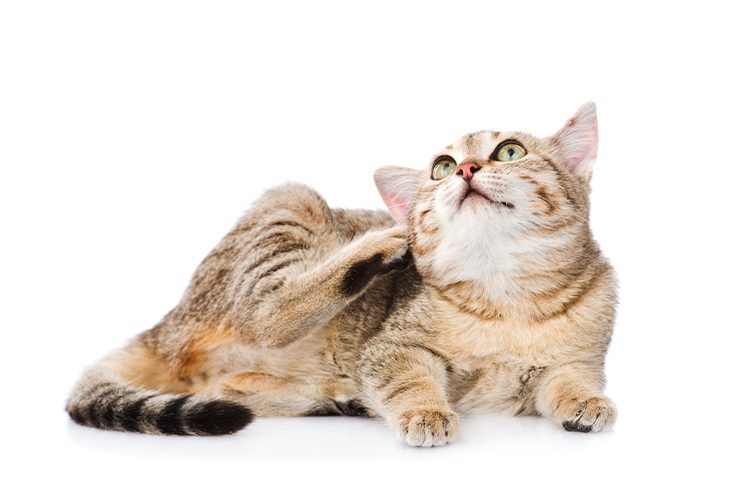
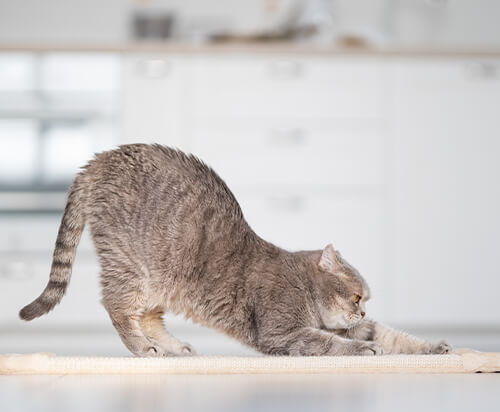
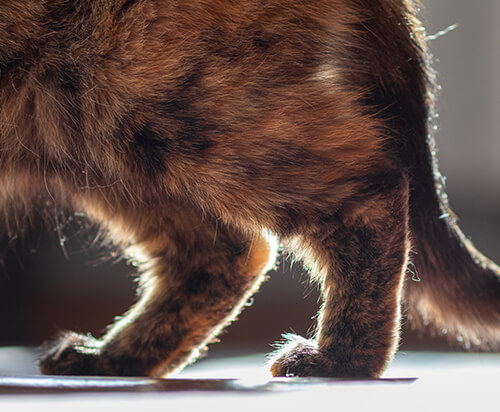
Declawing
Declawing (also known as onychectomy) is the removal of the last bone and the associated claw of each toe. This is an elective procedure, meaning that it is not a procedure that is required for the animal’s health or survival, but is instead performed by owner preference.
Declawing has probably become one of the most controversial of all the elective surgical procedures commonly performed by veterinarians. While it is normal for cats to scratch things (e.g. marking territory, conditioning claws, stretching, etc), this behavior can affect the bond between an owner and their cat. The declaw surgery provides an instant, permanent solution to these problems, but may contribute to chronic issues throughout the cat’s life. Numerous recent studies have shown that there can be adverse effects secondary to declawing, including chronic pain, increased risk for arthritis, increased risk of biting, or chronic stress responses (e.g. inappropriate urination, chronic respiratory infections, etc).
Possible Negative Consequences of Declawing your Cat
Initially after the procedure, there are several possible complications that could develop.
- Depending on how the procedure is performed, a piece of the bone from the toe could be left behind, resulting in chronic pain.
- Some cats will continue to bleed from their incision sites for up to a couple of days after the procedure. This is more common in larger or more active cats. Occasionally, some incision sites will break open completely, requiring the cat to be sedated again so these incisions can be repaired.
- There is also a risk for infection at the incision sites.
Chronic pain is one of the more common long-term complications associated with declawing. As a declaw procedure does involve removing bones from your cat’s foot, this does change how they stand and place weight on their feet. Long-term arthritis (in the feet and elsewhere in the body, such as the spine, hips, and shoulders) can develop secondary to this abnormal posture. Other cats appear to suffer from chronic pain in their feet, equivalent to phantom-limb pain in humans. Some cats will always have a limp or will hold their feet up more when sitting.
Some cats will also show a change in behavior after being declawed (both short-term and long-term). Declawed cats may have an increased tendency to bite. This is likely secondary to a combination of chronic pain and a lack of effectiveness in using their claws/feet. And, unfortunately, bite wounds can be a much higher danger to people than scratching because cat bite wounds very commonly become infected.
There have also been numerous studies showing a correlation between declawed cats and inappropriate urination (not using the litter box). Much of this is attributed to the chronic pain as noted above but a decreased desire to dig in litter has been noted in some cats as well.
Providing Appropriate Scratching Options
Scratching is a natural behavior of cats, which makes it difficult to stop completely. However, there are numerous things we can do to help your cat scratch in/on/at appropriate places. Every cat prefers different scratching surfaces so it can take a bit of experimentation to find your cat’s ideal scratching solution.
- Most cats prefer to scratch vertical surfaces (although horizontal surfaces can be preferred too). A sturdy post or surface that is taller than their body length is a good place to start.
- Most cats prefer sisal rope for scratching but corrugated cardboard, carpet, or natural bark/wood can all also be provided.
- One scratching spot is not enough! There should be options available in every room the cat regularly hangs out in.
- Provide appropriate scratching spots near the areas where your cats sleep as most cats like to stretch/scratch shortly after waking up.
Training to Scratch Appropriate Sites
- Never punish your cat for scratching inappropriate areas. This can lead to anxiety/stress, potentially increasing scratching and other abnormal behaviors (including fear of people). Your cat may also just learn to scratch when you’re not present. Instead, gently pick your cat up, take them to an appropriate scratching place, and provide a reward (ideally within 3 seconds).
- Discourage scratching at unwanted locations by making them less desirable. Most of these tricks are usually for short term discouragement and are rarely needed once your cat has established a proper scratching site(s).
- This can include placement of double-sided sticky tape, tinfoil, plastic, or furniture covers on some surfaces. This is rarely a permanent necessity and is usually only used during the initial training period. You can even find furniture protectors that have sisal fiber built into them!
- “Booby traps” can be set up using balloons, bowls of water, or other undesirable objects.
- You could also consider placing a scratching board/post near where your cat is scratching inappropriately to help deter them to an appropriate site.
- Some kittens may need to be confined to areas where appropriate scratching surfaces are available until they learn what is and is not appropriate.
- Use food, treats, catnip, or other desirable rewards to help entice your cat towards appropriate scratching areas. Playtime around/on appropriate scratching surfaces is encouraged as well. Most cats learn best by positive reinforcement of desirable behaviors!!
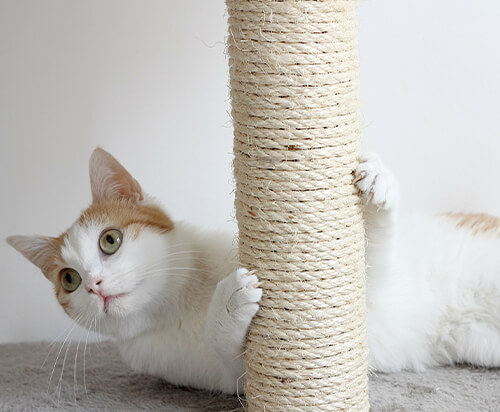
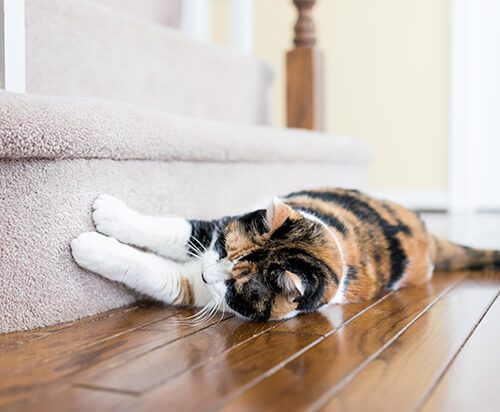
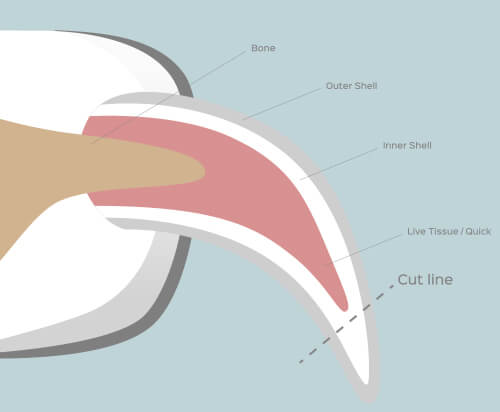
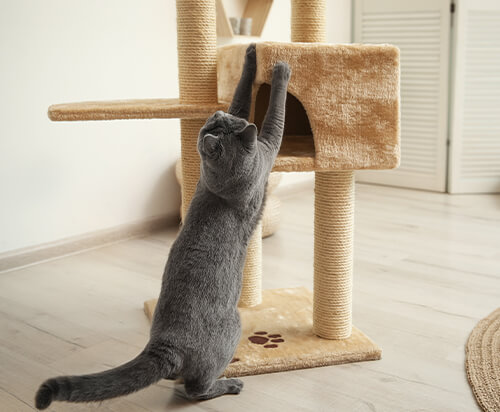
Nail Trimming and Nail Caps
Nails should be trimmed regularly. As kittens, it can be beneficial to trim the nails every 1-2 weeks to help them get comfortable with the process. It can also be beneficial to intentionally take a few minutes every day to gently manipulate your kittens’ toes so they are also comfortable with this type of handling. We would love to show you how to trim nails if you’re not familiar or comfortable with the procedure.
Nail caps (e.g. “Soft Paws”) can provide a covering for your cats’ nails so even if they scratch you or your furniture, there is no sharp edge that will cause damage. These caps come in a variety of sizes and colors. Application can initially be tricky but we are happy to show you how to apply these caps and will even apply them at regular intervals for a small charge.
Additional Tips to Discourage Scratching at People
- Teach all members of the family that cats should be treated with respect. No one should be allowed to play roughly with your cat or handle them in a way that causes fear, stress, or pain. A fearful cat will lash out inappropriately, resulting in unintended scratches/bites.
- Do not use your hands, fingers, feet, or toes for play. This just encourages biting and scratching in most cats. Instead, use toys pulled along the floor or feathers on wands as play toys. Make sure to provide a variety of toys for self-play as well (jingling balls, stuffed mice, etc).
- If your cat does start reacting inappropriately toward you (e.g. scratching/biting), the best thing you can do is to remove yourself from the situation. The more you negatively react to your cat (hitting back or other types of punishment), the more likely they will keep repeating the behavior. Even continued (but positive) interactions can result in encouragement of the behavior.
- Spaying or neutering your cat can help decrease aggression or other behavioral side effects that encourage scratching or biting.
- Spend some time learning “warning signs” that your cat may give before they scratch. This can include ear posture or tail flicks. Once you’re familiar with these signs, you can then use them to your advantage and discontinue any interaction before it reaches the stage of a scratch or bite.
Provide Adequate Resources in the Household
Every cat in the household should have equal access to litter boxes, sleeping/resting areas, food/water, scratching surfaces and toys. We know this doesn’t always sound directly related to scratching but territorial marking/scratching can result from any deficiencies in the following:
- There should be one more litter box than the number of cats you have (2 cats = 3 litter boxes) and they should be spread out throughout the house (e.g. on multiple levels). The litter boxes should be scooped at least once daily.
- Cats should be fed separately (so that they can’t see each other) to prevent tensions regarding food availability and food guarding.
- Perches and resting spots should be spread out so that each cat has the opportunity for a space where they can relax and/or monitor their environment. Most cats prefer sunny spots or windows to watch out from.
- Address any inter-cat tensions that may be causing fear/anxiety. Signs can be subtle but may include one cat chasing the other, guarding of resources, growling/hissing, etc. Products such as Feliway pheromone diffusers can go a long way in some cases. We also have many other products for anxiety that we would be happy to discuss with you.
In Summary
It is definitely possible to have a happy and long-term relationship with a cat with claws. Starting young is the best way to head off problems but there are solutions for cats of any age.
It is our mission to improve the lives of all the patients we see. And a cat that has all their claws will live a longer and healthier life so there will be more happy moments to share!
We know there may be questions or concerns about our new declawing policy so please do not hesitate to reach out to us.
*Original source Dr. Terri Argotsinger, https://www.ankenyvets.com/how-to-live-with-a-clawed-cat-and-why-were-not-declawing-anymore/
Reprinted and/or resourced with permission of Ankeny Animal and Avian Clinic, Ankeny, Iowa.

